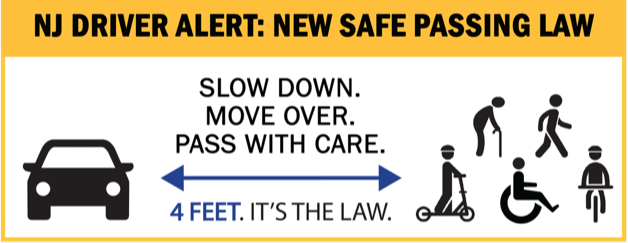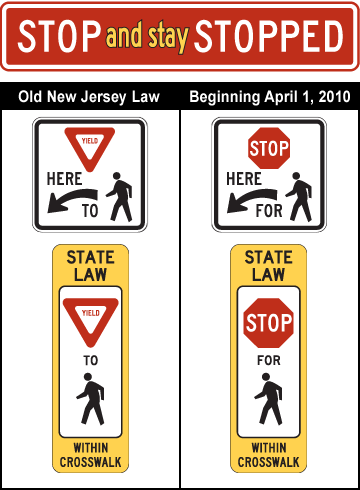Safe Passing Law
The NJ Safe Passing Law (NJSPL) (A5570/S2208) is now in effect. The new law provides clear rules of the road for all motorists about when and how to pass people sharing the road on foot, on bicycles, on scooters, wheelchairs or in other legally permitted ways to travel other than a motor vehicle.

The Safe Passing Law requires drivers to use “due caution” whenever they see vulnerable people on the road. The law states that:
- Drivers must follow all current no-passing, no speeding laws AND move over a lane if there’s one to move into.
- On a single-lane road, drivers must allow at least a 4-foot safety zone when they pass.
- If 4 feet is not possible on a section of road, drivers must slow to 25mph and be prepared to stop until they can pass safely without endangering those sharing the road.
Stop and Stay Stopped
Motorists who see pedestrian(s) in a marked crosswalk MUST:

MOTORISTS in New Jersey MUST stop for pedestrians in a marked crosswalk. Failure to observe the law may subject you to one or more of the following:
- 2 POINTS
- $200 FINE (plus court costs)
- 15 DAYS COMMUNITY SERVICE
- INSURANCE SURCHARGES
- NEW JERSEY STATUTE 39:4-36
Driver to stop for pedestrian:
exceptions, violations, penalties.
A. The driver of a vehicle must stop and stay stopped for a pedestrian crossing the roadway within any marked crosswalk, but shall yield the right-of-way to a pedestrian crossing the roadway within an unmarked crosswalk at an intersection, except at crosswalks when the movement of traffic is being regulated by police officers or traffic control signals, or where otherwise prohibited by municipal, county, or State regulation, and except where a pedestrian tunnel or overhead pedestrian crossing has been provided, but no pedestrian shall suddenly leave a curb or other place of safety and walk or run into the path of a vehicle which is so close that it is impossible for the driver to yield.
Whenever any vehicle is stopped to permit a pedestrian to cross the roadway, the driver of any other vehicle approaching from the rear shall not overtake and pass such stopped vehicle.
Every pedestrian upon a roadway at any point other than within a marked crosswalk or within an unmarked crosswalk at an intersection shall yield the right-of-way to all vehicles upon the roadway.
B. A person violating this section shall, upon conviction thereof, pay a fine to be imposed by the court in the amount of $200. The court may also impose a term of community service not to exceed 15 days.
C. Of each fine imposed and collected pursuant to subsection B. of the section, $100 shall be forwarded to the State Treasurer who shall annually deposit the moneys into the “Pedestrian Safety Enforcement and Education Fund” created by section 1 of PL 2005, c 84 (C.39:4-36.2)
PEDESTRIANS MUST obey pedestrian signals and use crosswalks at signalized intersections. Both carry a $54.00 fine for failure to observe the law.
(C.39:4-32 and 33)
Pedestrian Safety Education and Links
New Jersey experiences a disproportionate number of pedestrian injury crashes and fatalities compared to the nation as a whole. To combat the problem, the Division of Highway Traffic Safety assists local and county agencies in the development of comprehensive pedestrian safety programs involving Education, Enforcement, and Engineering.
The Education component of the pedestrian program involves getting the pedestrian safety message to all members of the community, with a special emphasis on three high-risk groups: children, senior citizens and non-English speaking residents.
The Enforcement component involves targeted police patrols at high pedestrian-crash locations in the community. During these patrols warnings and summonses are issued to motorists and pedestrians whose actions put pedestrians at risk. Stop for pedestrian and jaywalking laws are emphasized.
The Engineering component provides traffic engineering assistance such as enhanced crosswalk striping and signs.
Comprehensive Pedestrian Safety Grants funded by the Division have been very successful. On average, participating municipalities have seen a [20-percent first year] reduction in crashes involving pedestrians.
The most important pedestrian safety message for New Jersey residents is: Pedestrian Safety is a Shared Responsibility.
There is no one cause of crashes involving pedestrians. Pedestrians and motorists must both do their part to keep pedestrians safe.
Pedestrians:
- Always cross at corners, within marked crosswalks where available.
- If crossing in other locations, yield the right of way to vehicles. Failure to obey the law carries a $54 fine (court costs additional; C.39:4-32, 33)
- Look left, right and left again before crossing. Watch for turning cars.
- Always walk facing traffic.
- Obey traffic signals, especially “Walk/Don’t Walk.”
- Remain alert! Don’t assume that cars are going to stop.
- Wear reflective clothing when walking at night.
- Stay sober. Walking while impaired greatly increases your chances of being struck.
Motorists:
- Stop for pedestrians in marked crosswalks. Failure to stop carries a $200 (court costs additional) fine, a 2 point license penalty, 15 days community service, and insurance surcharges. (C.39:4-36)
- Watch for pedestrians when turning right on red.
- Obey speed limits.
- Do not block or park in crosswalks.
- Keep your windshield clean for maximum visibility.
- Be alert for pedestrians at all times.
Children and senior citizens are at a higher risk of being struck by a motor vehicle. Special emphasis must be made to educate children and seniors about the importance of walking safely.
Children:
- Cross at intersections only.
- Never cross from in-between parked cars.
- Before crossing, look left, right and left again and listen for traffic.
- Always walk facing traffic.
- Wear light colored or reflective clothing at night.
- If there is no sidewalk available, walk as far off the roadway as possible on the left side of the road, facing oncoming traffic.
- Obey all traffic signs and signals.
Seniors:
- Walk on sidewalks and cross only at corners, within marked crosswalks where available.
- If crossing in other locations, yield the right of way to vehicles. Failure to obey the law carries a $54 fine (court costs additional; C.39:4-32, 33)
- Always walk facing traffic.
- Wear bright-colored or reflective clothing, especially at night.
- Look left, right and left again before crossing and be on the lookout for turning vehicles.
- Make eye contact with the driver before crossing in front of a vehicle.
- Learn the proper use of “Walk/Don’t Walk” signals.
- Use the buddy system. Walk and cross with others when possible.
- If possible do not walk at night or during bad weather such as snow, rain or ice.
Links:
NJ Bike and Walk Coalition – NJ Safe Passing Law Website
Be Street Smart
Street Smart is New Jersey’s pedestrian safety program. Their comprehensive web site contains information, resources, education and news that focuses on reducing pedestrian/motor vehicle crashes in New Jersey.
Crosswalk Warning Palm Card – This palm card is being used throughout New Jersey by law enforcement officers to educate motorists and pedestrians about the pedestrian law.
How to Implement the Street Smart NJ Pedestrian Safety Campaign in Your Community
Developed for use by municipalities statewide, this booklet provides information to help communities create a pedestrian safety campaign targeting both pedestrians and drivers. It covers all facets of implementing the campaign from data analysis and selection of pedestrian safety hot spots to grassroots community outreach and evaluation.
NJ Walks and Bikes – Bicycle and Pedestrian Newsletter
Pedestrian Safety Crosswalk Law video – A 30-second TV PSA providing information on pedestrian safety, including the “Stop and Stay Stopped” law, which became effective in New Jersey on April 1, 2010.
English l Español
Pedestrian Safety Palm Card
Developed as part of Street Smart, New Jersey’s pedestrian safety program, this palm card contains pedestrian law information for both motorists and pedestrians as well as a tip section that will help keep “Garden State” residents safe while traveling on foot.
Railroad Crossing Safety –
Safety tips, links and sign information for motorists, pedestrians and bicyclists about how to safely pass through a railroad crossing
Safe Routes Scoop – A newsletter that promotes safe and healthy walking and biking to school in New Jersey.
Safe Routes to School for Law Enforcement – A website launched by NHTSA aimed at providing local law enforcement with the information and resources necessary to help support or start a successful Safe Routes to School program.
School Zone…Danger Zone – Developed by the Municipal Exchange Liability Joint Insurance Fund (MEL), this 10 minute 48 second video points out how important it is for parents to know and follow their school’s student drop off plan, understand and convey to their children the function of school crossing guards, and serve as positive role models by adhering to and reinforcing traffic safety laws. English l Español
“School Zone…Danger Zone” Tip Sheet – Parents can print out this one-page tip sheet, designed to accompany the School Zone..Danger Zone” video, and use it to facilitate a discussion about traffic safety with family members.
English l Español
Stop and stay Stopped Flyer – At 8.5″ x 11″, this flyer illustrates the signage differences brought about by the new “Stop and stay Stopped” law.




